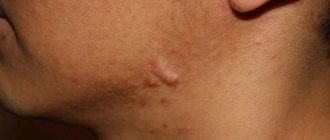A child’s immature immune system often causes allergic rashes. Externally, this is manifested by the appearance of redness on the skin accompanied by itching, blisters and other skin rashes. Obviously, the mother in this situation is concerned about many questions: “How to get rid of an allergic rash?”, “What to do to prevent the rash from appearing?”, “What is first aid in case of an acute reaction of the body to an allergen?”, “How long does it take to pass?” allergic rash?
Types of rash
Rashes on the abdomen of a child are quite variable in nature and etiology (origin).
Pediatricians distinguish the following types of rash:
- Spots are areas with clear boundaries on the surface of the skin of a discolored color (spots do not protrude above the skin and cannot be felt during palpation);
- Papules are tubercles up to 5 mm in diameter, without an internal cavity and protruding above the skin;
- Plaques are formations raised above the surface of the epidermis, significant in area, having a flattened shape;
- Vesicles are formations with liquid contents;
- Bubbles are vesicles more than 5 mm in diameter;
- Pustules are cavities limited by the membrane with purulent contents.
Some diseases are also characterized by peeling of the skin. Any changes in the appearance of the skin surface are a signal that not everything is in order in the baby’s body. Of course, not all diseases accompanied by a rash require special therapy, but such signs should not be ignored in any case.
Causes of the rash
The most likely causes of abdominal rashes in childhood are:
- Irritation of an allergic nature. There are a lot of allergens that provoke a reaction from the immune system. A skin rash can be caused by formula or mother's milk (if the mother herself consumed allergenic foods). The main method of therapy for allergic rashes is identifying the allergen and eliminating it.
- Infectious lesions of the body. In such cases, the rash is usually severe and is accompanied by other symptoms (high fever, signs of general intoxication of the body).
- Impact of external factors. Prolonged contact with wet underwear and untimely diaper changes can cause prickly heat in infants and older children.
- Insect bites - mosquitoes, bedbugs, fleas.
- Taking medications - any medications can have side effects in the form of rashes, itching and other manifestations.
You should not try to determine the cause of the rash on your own - a qualified specialist in childhood diseases will do this more effectively. If a rash on a child’s stomach is accompanied by additional symptoms, calling a doctor is mandatory.
Read also: Allergies in children
Characteristic symptoms
It is important for young parents to figure out whether the rash that appears is an allergic reaction or is it a source of dangerous infectious diseases.
Characteristic features of an allergic rash in a child are:
- Swelling of the face (with an infectious etiology of the rash, swelling is not observed)
- Skin itching (often accompanies a rash of an allergic nature, less often - infectious)
- No high fever (infectious infection is accompanied by a sharp increase in body temperature).
An allergic rash on the back, abdomen, neck, and arms is often accompanied by clear mucus discharge from the nose. In infectious diseases, mucus quickly thickens, becomes cloudy, with a greenish tint.
The nature of possible rashes can be seen in the photo.
The skin reacts with the appearance of pimples, blisters, papules, round spots, often with exudate, then they can develop into a continuous swollen surface, sometimes covered with a crust. With severe itching, irritability may appear.
An allergic rash in infants mainly appears in the upper part of the body, in the folds, and may be accompanied by swelling of the facial organs: tongue, larynx area, which causes risks of suffocation. If symptoms such as nasal congestion, lacrimation, swelling of the cheeks occur, parents should not hesitate, but call an ambulance, since the development of Quincke's edema may become a complication.
What diseases can be accompanied by a rash on the stomach?
There are dozens of diseases that can cause spots, rashes, itching and redness on the skin on the abdomen.
The most common options:
- Chickenpox is an acute viral disease accompanied by a small rash on the body, including in the abdomen;
- Scabies is a disease caused by scabies mites (characterized by the appearance of small vesicles mainly in the navel area);
- Measles is a viral pathology accompanied by high fever and the appearance of dark spots on the skin;
- Scarlet fever is a bacterial disease, which, in addition to general symptoms, is characterized by the appearance of a small rash in the lower abdomen;
- Lyme disease is a pathology transmitted by ticks (the earliest symptom of the disease is red spots at the site of the bite);
- Dermatitis is the most common type of allergy.
If you detect a rash in a timely manner and classify its nature, you can quickly identify the disease, prescribe adequate and correct therapy, and prevent the consequences and complications of the pathology. Sometimes rashes on the abdomen require immediate therapeutic intervention. The most appropriate and reasonable course of action for parents who discover spots on their child’s belly is to seek help from a professional pediatrician. An experienced doctor sometimes only needs one look at the rash to understand what he is dealing with.
Children's diseases with rash. Vaccinations and immunity assessment
Most childhood infections are accompanied by various rashes. A rash is a general reaction of the body to the toxic effects of a pathogen and its waste products, and the child has an accelerated metabolism, wide blood vessels and good blood circulation.
Children's diseases are best dealt with in childhood. Firstly, this is how the child’s immunity is formed and protection against infections in the future. Secondly, in adulthood, childhood diseases are much more severe, and many of them are especially dangerous during pregnancy.
All infections are highly contagious, progress with fever and have symptoms of a cold. Often, characteristic signs of the rash allow them to be distinguished from each other. Let's look at the main childhood diseases and their distinctive features:
Measles
Recently it was believed that measles had been defeated, but recently outbreaks have been occurring more and more often. This is due to the refusal of mandatory preventive vaccinations. In fact, measles is a serious disease, especially in adolescence and adulthood. It occurs with complications: pneumonia, otitis, and frequent damage to the kidneys, liver and brain. May lead to deafness and blindness. The measles rash is maculopapular (papules - small elevations on the skin), appears on the 3rd day of illness, begins behind the ears and on the face and appears in stages from top to bottom, can have different sizes (polymorphic). Before the appearance of the rash, you can notice white dots on the mucous membrane of the oropharynx, reminiscent of semolina, with a red rim; they are called Filatov-Koplik spots.
Chicken pox
Caused by herpes virus type III. Most children become ill between the ages of 2 and 7 years; at older ages it is more severe. Everyone knows that the rash with chickenpox is in the form of blisters (vesicular). It starts from the scalp, spreading throughout the body. First, spots appear, which successively turn into papules and itchy blisters with transparent contents, leaving behind crusts. All these elements can be simultaneously observed on the child’s body. In adults, the infection can occur as shingles.
Rubella
It is highly contagious, often mild in both children and adults, and therefore may go undetected. It is particularly dangerous during pregnancy, as it can lead to the formation of fetal developmental abnormalities for up to 12 weeks. Typical manifestations: enlargement of the occipital and posterior cervical lymph nodes, a small spotted rash, without pain or itching.
Scarlet fever
Caused by group A beta-hemolytic streptococcus. It manifests itself as a sore throat and a typical pinpoint rash against the background of severe redness of the skin. Most of the rash elements are in the area of the flexor surfaces and they tend to merge. The nasolabial triangle always remains free of rash. Another sign is a bright red tongue.
Erythema infectiosum
Caused by parvovirus B19. In children, it is widespread, mild, with signs of a cold, and possible headache. The hallmark is bright redness of the cheeks, which is why parvovirus infection is better known as “slapped cheek disease.” Dangerous in the first trimester of pregnancy.
Roseola
Caused by herpes virus type VI. Mostly children under 5 years of age are affected. The disease is rarely recognized because in the first 3 days the temperature rises sharply to 39-40 degrees, on the 4th day it drops to normal numbers without signs of a cold, and a rash resembling rubella appears. Few people realize that these are manifestations of the same disease. In adults it causes chronic fatigue syndrome.
We have looked at the typical manifestations of the rash. But recently, the classic course of the disease has rarely occurred. In addition, rashes can occur with other infections: caused by the Epstein-Barr virus, cytomegalovirus, yersiniosis, viral hepatitis, and so on. The most correct position of a parent in the event of a rash in a child is to call a doctor at home or an ambulance to rule out severe, life-threatening infections, for example, meningococcal.
Why are vaccinations needed?
Vaccination against measles is mandatory and is included in the National Vaccination Calendar. There are vaccines against chickenpox and rubella; the latter is being discussed as mandatory for girls.
How do you know if you have immunity to childhood infections?
For this purpose, antibodies are determined - immunoglobulins class G (IgG). These are proteins of the immune system that appear in the body when a pathogen enters the body and persist for a very long time or for life. Their identification indicates good immunity and protection from re-infection.
But it should be remembered that IgG can be determined during the current disease. If there is a clinic, then IgM and IgA are simultaneously determined, as well as the identification of the pathogen by PCR.
The KDL laboratory offers to determine immunity to the following infections:
- Antibodies to measles virus, IgG
- Antibodies to the Varicella-Zoster virus, IgG – determination of immunity to chickenpox
- Antibodies to rubella virus, IgG
- Antibodies to parvovirus B19, IgG
- Antibodies to the herpes virus type VI (Human Herpes virus VI), IgG – to the causative agent of roseola
Who is indicated for determining immunity to childhood infections in the first place?
- Against measles - for everyone. If IgG is not detected, therefore, there is no protection and revaccination is recommended in order to avoid infection.
- When planning pregnancy - if there is no immunity, vaccination is indicated to provide protection against infections that can cause intrauterine damage to the fetus (rubella, parvovirus B19)
- Early in pregnancy (first 12 weeks). Infection during this period is most dangerous, since all the organs and tissues of the baby are formed). If IgG is detected, there is no risk of infection.
Get examined by the KDL laboratory in a timely manner and be healthy!









